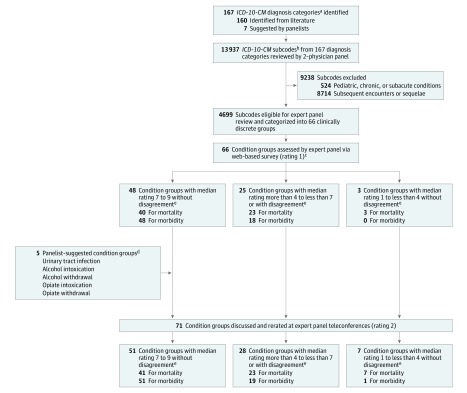Figure. Process of Identifying and Rating Emergency Care–Sensitive Condition Groups.
Number of condition groups categorized into 3 rating groups do not sum to total condition groups because some were categorized differently for mortality and morbidity (ie, acute appendicitis was rated a median of 6.5 for mortality, putting it in the middle group, and rated a median of 7 for morbidity, putting it in the emergency care–sensitive group). ICD-10-CM indicates International Statistical Classification of Diseases, Tenth Revision, Clinical Modification.
aRefers to the 3-character label for a disease category (eg, I21, acute myocardial infarction).
bSubcodes describe the disease or injury etiology, anatomic site, severity, and encounter type (eg, I21.09: ST-elevation myocardial infarction [STEMI] involving other coronary artery of anterior wall).All included and excluded subcodes rated as highly sensitive to emergency care are listed in the eAppendix in the Supplement.
cPanelists were asked the 2 following questions: (1) for the average patient with this condition, to what extent does timely emergency care affect subsequent mortality, and (2) for the average patient with this condition, to what extent does timely emergency care affect subsequent morbidity. Panelists responded with a rating from 1 (no or little impact) to 9 (strong impact).
dFor the 5 panelist-suggested condition groups, 119 ICD-10-CM subcodes were reviewed. Overall, 30 new subcodes were included, and 89 were excluded because they indicated pediatric, chronic, or subacute conditions. None of the subcodes indicated subsequent encounters or sequelae.
eDisagreement was defined as least 3 panelists rating the condition group in the range of 7 to 9 and at least 3 panelists rating the condition group in the range of 1 to less than 4.

